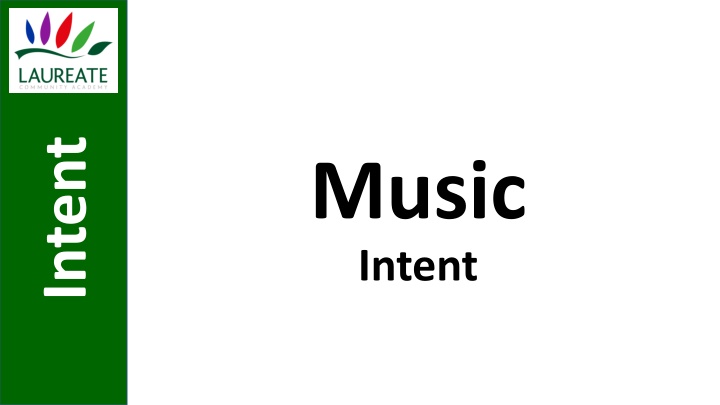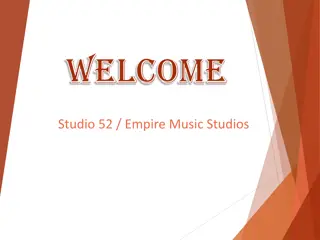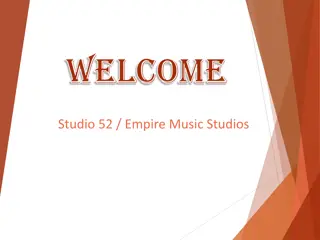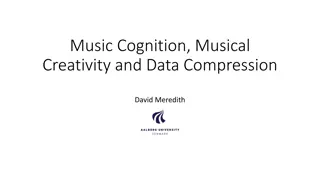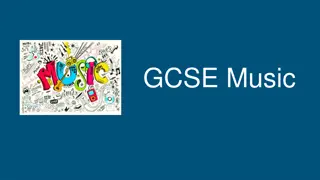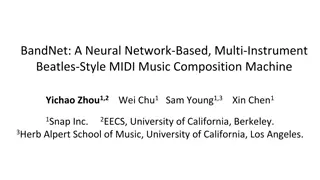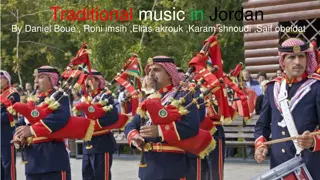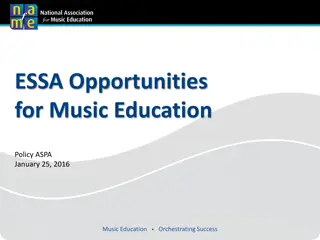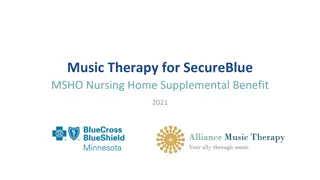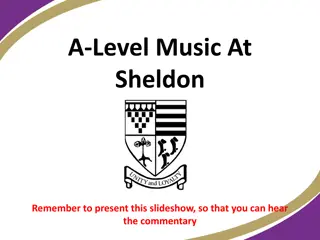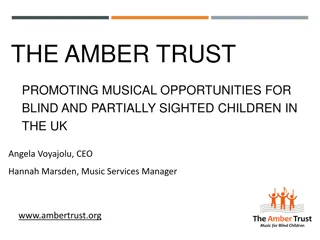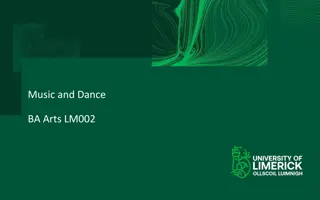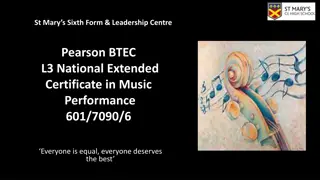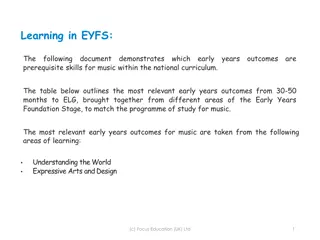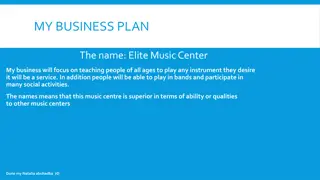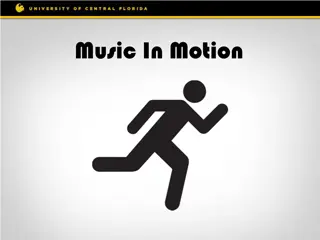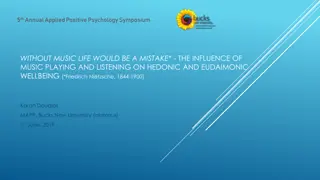Importance of Music Education for Children
Music education plays a crucial role in helping children express themselves, develop creativity, and enhance social skills. The National Curriculum in England emphasizes the significance of providing high-quality music education to pupils, fostering a love of music, creativity, and self-confidence. The curriculum aims to engage students in using their voices, playing instruments, listening to music, and experimenting with sounds across different key stages. Through music, children can explore emotions, collaborate with peers, and build a strong foundation for their musical development.
Download Presentation

Please find below an Image/Link to download the presentation.
The content on the website is provided AS IS for your information and personal use only. It may not be sold, licensed, or shared on other websites without obtaining consent from the author.If you encounter any issues during the download, it is possible that the publisher has removed the file from their server.
You are allowed to download the files provided on this website for personal or commercial use, subject to the condition that they are used lawfully. All files are the property of their respective owners.
The content on the website is provided AS IS for your information and personal use only. It may not be sold, licensed, or shared on other websites without obtaining consent from the author.
E N D
Presentation Transcript
Intent Music Intent
Music Why is music important? Intent Music can be used to help children express themselves and their emotions. Children are encouraged to experiment, through improvisation, composition and in using a range of instruments, to find different ways in which to be creative, while at the same time finding a way to demonstrate their emotions in a constructive manner and relate to others. It allows children to explore their creativity and expression along with their team working skills by closely working with other pupils.
Music National Curriculum statutory content The National Curriculum for maintained schools in England stipulates that all pupils should have access to a high-quality music curriculum. Academies and free schools are not required to follow the National Curriculum. However, Ofsted still expects them to teach a curriculum that is at least as broad and ambitious as the National Curriculum. This includes Music. Intent In March 2021, the Department for Education published their Model Music Curriculum. This non-statutory guidance outlined a framework for how the concepts outlined in the National Curriculum may be delivered in schools in key stages 1, 2 and 3. CUSP Music aligns with all key principles of the Model Music Curriculum but moves beyond providing just the framework for this, to provide teachers with lesson-by-lesson planning that will support even non-specialist practitioners in delivering excellence in Music. Within the National Curriculum, clear guidance is given around expectations of the purpose of learning music. This includes instilling a love of music and the development of creativity and self-confidence. Key aspects of study that are explicitly referenced in the National Curriculum for Music include: listening and appraising singing playing tuned and untuned instruments reading musical
Music Aims of the Music Curriculum Key Stage 1 The national curriculum for music in Key Stage 1 aims to ensure that all pupils: Intent use their voices expressively and creatively by singing songs and speaking chants and rhymes play tuned and untuned instruments musically listen with concentration and understanding to a range of high-quality live and recorded music experiment with, create, select and combine sounds using the interrelated dimensions of music.
Music Aims of the Music Curriculum Key Stage 2 The national curriculum for music in Key Stage 2 develops this knowledge and these skills further to ensure all pupils: Intent play and perform in solo and ensemble contexts, using their voices and playing musical instruments with increasing accuracy, fluency, control and expression improvise and compose music for a range of purposes using the interrelated dimensions of music listen with attention to detail and recall sounds with increasing aural memory use and understand musical notations appreciate and understand a wide range of high-quality live and recorded music drawn from different traditions and from great composers and musicians
Music We use CUSP for our music planning. It has been purposefully built around the principles of evidence-led practice. This is to ensure that there is a focus on high-quality development of children as musicians. The curriculum is carefully designed to build pupils musical knowledge and develop their competency and confidence as musicians. Each block includes the study of significant musicians and musical works, with the intention of exposing pupils to a wide range of music that will inspire them and connect them to the world around them. The curriculum is built to support non-specialist teachers in developing their own subject knowledge and delivering excellence in music education. Intent Core areas of study include singing, listening and appraising, composing and improvising and instrumental performance. These are built cumulatively throughout the curriculum to ensure that all pupils develop their engagement with, and knowledge of, music over time. This includes a focus on learning to play a range of instruments confidently. CUSP Music aims to build a strong and rich musical culture in schools, in which pupils can thrive. As with all CUSP subjects, CUSP Music has a strong emphasis on the language that pupils need to explore their own musicality. This is carefully and deliberately planned so that pupils revisit and embed this knowledge over time. Clear structures and learning routines underpin CUSP Music. This allows pupils (and teachers) to direct their cognitive attention to the core content in each block. As with all CUSP subjects, Knowledge Notes
Early Years Intent
Music in EYFS Intent
Music in EYFS Intent
Music in EYFS Intent
How is CUSP Music organised? Pupils will be taught to read music from the earliest stages with the expectation of this gradually developing as pupils experience base builds. Music from a wide range of cultures, time periods and traditions is studied across the curriculum, with plenty of opportunities for pupils to revisit significant musicians and compositions within and across years. This is important to help pupils embed learning and make connections between what they already know and their new learning. Intent What pupils will know and be able to do is clearly outlined in each block. Teachers should keep this as their key focus for each block of study but also exploit every opportunity to build on pupils prior knowledge, as these strong foundations will support pupils in deepening their understanding over time.
Content and Sequence: Year 1 Intent
Content and Sequence: Year 2 Intent
Content and Sequence: Year 3 Intent
Content and Sequence: Year 4 Intent
Content and Sequence: Year 5 Intent
Content and Sequence: Year 6 Intent
Music Implementation Implementation
Teaching At Laureate Community Academy, music is taught weekly or as a blocked day across each year group. Implementation CUSP Music is taught from Years 1 6. Each year group has 6 blocks of 5 weeks teaching. Additional weeks in the academic year can be used for consolidation, revisiting or enrichment. The curriculum is designed to be delivered in 45 60-minute lessons, depending on the age of pupils and stage of learning. Schools can choose how to organise this time within their timetable, for example, teachers may choose to deliver one CUSP Music lesson over two shorter blocks of time. Across the year, each year group will focus on developing singing, playing a range of untuned and tuned instruments and building their knowledge about music. Pupils will build their knowledge and musical skills year on year, becoming more expert in playing and appraising a wide range of musical styles.
The Big Ideas At Laureate Community Academy, we aim to support all children to see themselves as musicians. Through our music curriculum, children gain a firm understanding of what music is by listening, singing, playing, evaluating, analysing, and composing across a wide variety of historical periods, styles, traditions, and musical genres. We are committed to developing a curiosity for the subject, as well as an understanding of a range of different genres of music and their different features. It is through these features that children come to understand how music can be used to express themselves and their emotions. Pupils are encouraged to experiment, through improvisation, composition and in using a range of instruments, to find different ways in which to be creative, while at the same time finding a way to demonstrate their emotions in a constructive manner and relate to others. We aim to provide children with the opportunity to confidently progress in their creativity and expression along with working with other pupils. Implementation
Minimum lesson expectations Teachers will use the CUSP Music plans that can be found on the CUSP website. Lessons will involve all children and will be a mix of whole class, group and individual work. Children will be given as many opportunities to perform to each other as possible. Teachers will model the skills needed within the lesson. Following each lesson the whole class assessment sheet will be filled in and will reflect any misconceptions, next steps, pupils who are a cause for concern, and any personal praise. Implementation
Vocabulary There is some vocabulary that is more year group specific and there is wider, overarching vocabulary that is relevant to all year groups that is part of the interrelated dimensions of music. These key words are: Implementation Pulse the regular heartbeat of the music; its steady beat. Rhythm long and short sounds or patterns that happen over the pulse. Pitch high and low sounds. Tempo the speed of the music; fast or slow or in-between. Dynamics how loud or quiet the music is. Timbre all instruments, including voices, have a certain sound quality. Texture layers of sound working together to make music interesting to listen to. Structure every piece of music has a structure e.g. an introduction, verse, chorus and ending. Notation the link between the sound and symbol. Children are encouraged to use the correct musical vocabulary when discussing their work, other people s work and musical styles and techniques. Key vocabulary for each unit is clearly outlined in unit planning.
Tailoring for SEND We plan for the first 20% and scaffold the lesson and tasks to meet their needs. Then we remove the scaffolding, as appropriate, to meet the needs of other pupils. We aim to provide all children with the opportunity to confidently progress in their creativity and expression along with working with other children. We strive for all children to access the music curriculum equally, but this can vary in how it looks depending on individual's needs. Implementation CUSP Music has a strong emphasis on the language that pupils need to explore their own musicality. This is carefully and deliberately planned so that pupils revisit and embed this knowledge over time. This key vocabulary is pre-taught for pupils who may need this. Symbols and signs are used alongside the oral to help embed their understanding. Examples are seen below:
Tailoring for SEND continued Some pupils may require individual task boards to enable them to follow a series of steps where a task has been broken down into smaller, more manageable chunks. Implementation Some pupils may have a hearing impairment. Teachers should think carefully about how this impacts their ability to hear and produce sounds and consider how best to adapt the Music lessons to ensure these pupils can be successful. Some pupils may have a visual impairment. This may impact their ability to read and follow musical notation. Teachers should think carefully about how they can adapt these lessons, possibly including the use of technology, to ensure that these pupils can access the same high-quality curriculum experience. For some pupils who have specific challenges around processing, some of the lessons may require adaptation to ensure that all pupils can participate fully in the lesson. This may mean reducing the number of instructions or steps in a task, introducing the use of a reader for lessons with a reading element (including lyrics), or any other adaptations specific to the pupils in your class.
Continuous Professional Development All staff have undergone CPD in Cognitive Load Theory, Spaced Practice Retrieval Theory and planning the wider curriculum which has supported the development of a modular wider curriculum. In addition, staff have been trained in the Theory of Reading which emphasises the importance of teaching reading across all subjects and how to teach vocabulary including etymology and morphology. Implementation
Music Impact Impact
Teacher Assessment Assessment of Music should be formative and based on the pupil outcomes from each lesson. The following can be used to assess pupils knowledge and understanding of music and musical skills: Expectations of what pupils will know and be able to do are included on the front page of each block. The Point of Reflection notes provide clear outcomes for each lesson. Pupils should know and remember the key language that is delivered cumulatively throughout the curriculum. Teachers can use the vocabulary quizzing during, at the end of and after each block to support pupils in embedding this. Questions for assessment are provided for each block. Teachers can use these as part of a Pupil Book Study structured discussion to help them understand what pupils have learnt over time. Impact
Teacher Assessment Whole Class Assessment Sheets are used throughout every lesson to ensure children are achieving the intended learning outcomes. Teachers are responsive to any needs identified and use this knowledge throughout the planning and assessment cycle. At the end of the unit teachers will use the Whole Class Assessment Sheets to secure a summative judgement for each child. Subject leaders will lead pupil conferencing and will also complete data analysis of Whole Class Assessment Sheets to monitor progress and identify next steps with the music curriculum. Impact
How do we measure the impact of music teaching? Subject Leaders use whole class assessment sheet analysis at the end of each term to analyse coverage, look at pupil percentages for who is WTS, EXS and GDS and to look at strengths and areas for development across the school. Impact
